Stick insects, sometimes referred to as “stick bugs” or “walking sticks,” are among the more peculiar-looking bugs one might encounter. Stick bugs are prevalent throughout the world, living on every continent, with the only exception being Antarctica. Stick bugs are very likely all around you, your home, and your property at any given moment, but you may never even know. So, it begs the question: what are stick bugs, and should you be concerned about them?
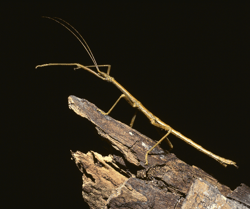
is it a stick bug or a twig?
As their name would suggest, stick bugs closely resemble twigs and are unmistakable if you can see beyond their camouflage. While not rare or uncommon in the United States, some might say they’ve never encountered a stick bug. Chances are you probably have stumbled on a stick bug, probably without even realizing it. These masters of camouflage are known for blending seamlessly with their natural surroundings, often nearly invisible to the naked eye. Are these hidden, expertly disguised insects lying in wait for an unsuspecting human to maim? Or are they harmless herbivores just trying to remain unseen and unbothered?
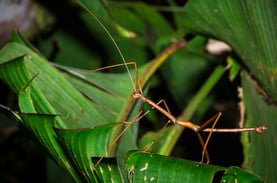
Is a stick bug a master of disguise?
Stick bugs belong to an order of insects called Phasmatodea, whose members are known by a variety of names, including stick insects, stick bugs, walking sticks, stick animals, or bug sticks. These insects are generally referred to as phasmids, which are large, cylindrical, tropical insects with long legs, an herbivorous diet, and a stick-like form. In North America, there are about 30 different species of stick bugs, some winged and others wingless. Most are tan, brown, or green in color, helping them fade into their surroundings.
As previously mentioned, stick bugs are experts in camouflage. This unique defense mechanism extends beyond their unusual stick-like appearance and muted, neutral color. Stick bugs use their uncanny ability to remain perfectly still so as to not draw attention to themselves and further blend into whatever twig or branch they’re perched on. Some even sway gently as if to mimic a branch moving softly in the breeze. The stick bug’s ability to disappear into their habitat is especially incredible considering their large size – some grow to be over 12 inches long!
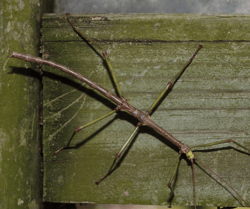
The Stick Bug’s Life Cycle
One of the most interesting aspects of the stick bug is its ability to reproduce pathogenetically. While some female stick bugs mate with males, others forgo the mating process and instead reproduce through a form of asexual reproduction. Female stick bugs have the ability to produce eggs without male fertilization. If this occurs, the eggs will hatch into female stick bugs. If a male stick bug fertilizes the female’s egg, there is a 50% chance the egg will become an adult male stick bug and an equal chance it will become a female. As you might imagine, this results in a disproportionate female-to-male stick population, with females far outnumbering males.
Stick Bug Life Cycle: Eggs
Generally, a female stick bug will lay over 100 eggs, with some species laying up to 1,000. Eggs can be laid in a variety of places, including in soil, hollow parts of plants, or even just dropped on the ground. Eggs that are dropped on the ground possess a capitula that houses sustenance for ants. Ants will then bring the stick bug eggs to their nests, where they feed on the capitula without destroying the hard-shelled embryo. Stick bug eggs that are commanded by ant colonies are actually safer and better protected from predators, allowing them to overwinter and hatch safely in the spring.
Stick Bug Life Cycle: Nymphs
Nymphs are similar to adult stick bugs but vary in color and size. They will continue to grow into adulthood by molting or shedding their outer skin to accommodate growth. Interestingly, the stick bugs will often consume their own old, shed skin. Nymphs can molt a number of times before reaching maturity, but most average between 4 and 8 times. Prior to reaching maturity, stick bug nymphs have the ability to shed limbs as necessary to escape predators. These lost limbs will be regenerated during the molting process. This helpful ability typically only lasts until the nymphs reach adulthood; however, some adults can force an additional molt to replace a lost limb.
Stick Bug Life Cycle: Adulthood
Stick bugs generally reach maturity about 3 months to a year after hatching. At this point, the stick bugs will have reached their full size, with the females typically being larger than the males. Female stick bugs tend to be larger than their male counterparts for a number of reasons. Chiefly, females require larger abdomens for the sake of producing eggs, and they need bigger mouths to consume more food. As adults, different stick bug species develop additional defense adaptations other than camouflage. Some grow sharp spines along their legs that are used for injuring predators, and others can release a burning, putrid liquid.
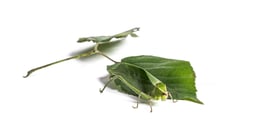
All About Stick Bugs: Diet, Behavior, and More
Stick bugs are herbivorous and generally nocturnal insects that pose little to no threat to humans. Most stick bugs will play dead during daylight hours, using their remarkable ability of total stillness to appear one with their surroundings. At night, stick bugs will feed on close-by shrubbery and leaves. Stick bugs are largely opportunistic feeders, meaning they will munch on pretty much any leafy green that is within reach. Some stick bug species do have preferred plants, but most are happy to eat whatever foliage is among them.
Despite the stick bug’s camouflage abilities, they are not immune to predators. Unfortunately, they are highly sought after by a number of larger insects and animals. Spiders, rodents, reptiles, and birds all prey on the stick bug. Bats are an especially worrisome predator for the stick bug, as they are active during the night when stick bugs venture out for food. Bat’s echolocation abilities are useful in pinpointing a stick bug’s location, providing them the upper hand in scoring a quick meal.
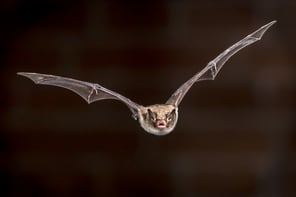
Do stick bugs make good pets?
Believe it or not, some people keep stick bugs as pets! In fact, some people claim that stick bugs make great pets as they are very low maintenance and are generally tame in nature. While not cuddly or furry, stick bugs can be wonderful pets for insect enthusiasts, so long as a few key points are kept in mind. Stick bugs are incredibly fragile and should be handled with extreme care. In addition, pet stick bugs are highly regulated, and proper research should be done prior to deciding to keep one as a pet. Be sure to check all of your local and state laws before getting any kind of insect. Stick insects that are not native to the US are illegal to keep, and EcoShield does not recommend keeping any exotic insects as pets.
What to do if you find a stick bug
Generally speaking, finding a stick bug on your property is not a cause for concern. Stick bugs very rarely cause damage to the landscape and foliage. They do not bite, sting, or attack humans. If you happen to come across a singular stick bug, don’t worry – while they look a little strange, they are not harmful to you, your family, or your pets. In most cases, you can simply leave them alone or admire them from afar.
While stick bugs rarely need treatment, occasionally, they can become invasive (especially in California), and EcoShield is ready to help if needed. However, should you have any questions or concerns about stick bugs in or around your home, please don’t hesitate to reach out to EcoShield. We’re happy to assist with any bug-related needs.
For all of your pest concerns, call EcoShield today: (888) 744-1284 or fill out the form on this page.